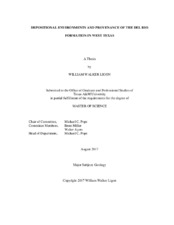| dc.description.abstract | The Middle Cretaceous Del Rio Formation is a calcareous shale interbedded with a few thin sandstone and limestone beds. The extreme variability within this unit makes it difficult to correlate regionally. However, analyzing outcrop data, hand samples, thin sections, core descriptions, wire line logs, and detrital zircons provides a clearer understanding of the regional stratigraphy, thickness variations, provenance and depositional environments of the Del Rio Formation across the Maverick Basin and west Texas.
The various lithologies within the west Texas Del Rio Formation are grouped into six facies that indicate deposition occurred in a shallow, subtidal marine environment within storm wave base. The facies and sedimentary structures indicate the Del Rio Formation was deposited on a homiclinal ramp. A ramp model is supported by the abundance of preserved storm deposits, and variability of facies and bedding among the outcrop sections. Sequences within the Del Rio Formation are inferred to be autocyclic because of the apparent randomness of facies distributions, and unresolvable sequence stratigraphic patterns within the measured sections. However, the Del Rio Formation as a whole is interpreted to be a single sequence representative of a lowstand preceding the Late Cenomanian transgression that deposited the Buda, Eagle Ford, and Austin Chalk formations.
The variability of thickness of the Del Rio Formation is due to onlap against preexisting topography of the Lower Cretaceous Edwards platform, and erosion beneath the Buda. The pre-existing Terrell and San Marcos Arches not only affected the thickness of the unit, but also the regional depositional settings. The Paleozoic Terrell Arch substantially impeded sediment transport to the west and therefore the depositional environment that produced the sandstone and siltstone beds to the east did not reach west of the arch.
The detrital zircon spectrum within the Del Rio formation contains age peaks corresponding to the Late Mesoproterozoic to Early Neoproterozoic (900-1300 Ma), Neoproterozoic/ Cambrian (500-650 Ma), Middle Paleozoic (350-500 Ma), Jurassic (170-175 Ma), and Middle Cretaceous (99-100 Ma).The siliciclastic grains within the Del Rio Formation were derived from multiple provenances. The most viable sources include the Ouachita Orogeny (recycled Gondwanan and Appalachian sediments), the Llano Uplift, and western volcanic arcs during the Jurassic and the Sevier Orogeny. | en |


